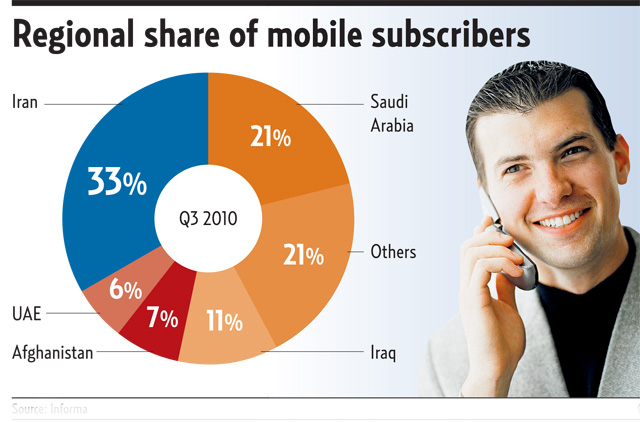Dubai: Mobile subscriptions in the Middle East are on track to cross the 300-million mark in 2014 after crossing 200 million in third quarter of this year, an industry expert said.
"Iran is the single biggest mobile market in terms of subscriptions followed by Saudi Arabia. Saudi Arabia is the most valuable mobile market in the Middle East with revenues of more than $11 billion [Dh40.45 billion] in 2010," Matthew Reed, Head of Mobile research, Informa Telecoms and Media, said at the GSM-3G Middle East Telco World Summit.
Iran has 66 million mobile subscriptions as of the third quarter while Saudi Arabia has 42.9 million subscriptions.
Meanwhile, the Palestinian market recorded the fastest growth this year to end of September, with mobile subscriptions increasing by 56 per cent.
"The rate of mobile penetration in the Mideast is rising and is expected to reach 93.9 per cent this year and touch 125.5 per cent in 2015. Afghanistan and Iran, with comparatively low penetration rates, will drive subscription growth in the region," he said.
New subscriptions
He said Middle East has been growing annually at more than 20 per cent with Iran posting the biggest growth with more than 12 million users added year-on-year. The average mobile penetration rate in the Middle East is around 85 per cent as of third quarter of 2010.
However, subscription growth rates in the region are slowing as the markets mature. So the operators need to focus more on retaining their customers.
Afghanistan has the lowest average revenue per user, followed by Yemen and Iran. Reed said Afghanistan is expected to have annual compound growth rate of 10.41 per cent in the next five years, followed by Iran at 10.16 per cent, Lebanon at 9.61 per cent and UAE at 4.7 per cent.
He said the Gulf is dominating the 3G market in the region, particularly Saudi Arabia with more than 2 million mobile broadband subscriptions. Around 7.5 per cent of Mideast mobile subscribers use 3G services while a number of major regional markets — such as Iraq and Iran — have yet to launch 3G networks.
Reed said that in 2015, mobile subscriptions in the region will reach 327 million after reaching 203 million in the third quarter of this year. Across the Middle East, he said, the proportion of prepaid subscriptions will rise slightly as most growth is likely to be among customers in lower-spending segments that tend to prefer prepaid accounts. At the end of 2015, prepaid connections will account for 88.6 per cent of the subscriptions, up from 88.4 per cent this year.
"New market entrants are making significant market share gains across the Mideast, prompting incumbent operators to accelerate the transformation of their businesses, to continue the search for new investment opportunities outside of the region and to invest in new network technologies such as Long-Term Evolution [LTE]."
In Saudi Arabia, Qatar, Bahrain, Kuwait and the UAE, the new players have had the biggest impact, he said. In Bahrain, Saudi Arabia and Kuwait the arrival of the third operators upset the status quo.
To combat competition from new players, he said, mobile operators have to develop new marketing skills and transform their internal organisations to focus on customer requirements.
"Mobile broadband services have been hugely successful right across the region and a major focus for the new players such as Mobily in Saudi Arabia and Viva Bahrain. HSPA services are fulfilling the requirement for basic connectivity but operators are already preparing for the arrival of LTE and many operators are doing trials across the region," Reed said.
According to Informa, by 2014, 3.5G+ technologies including LTE will be the biggest single technology segment of the Mideast market, accounting for 41 per cent of the subscriptions in the region. But LTE will be introduced in phases, as its development has come through a string of technologies from Global System of Mobile communication (GSM), Wideband Code Division Multiple Access (WCDMA) to High Speed Packet Access (HSPA) and to LTE.













